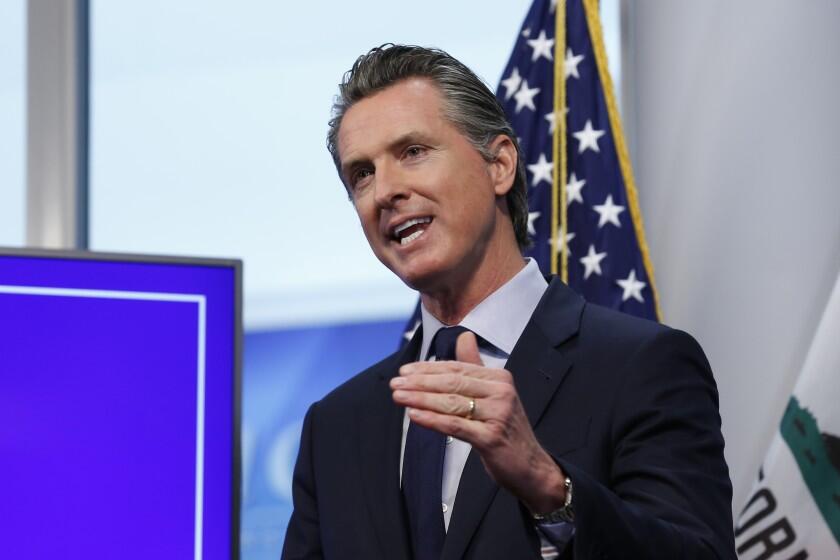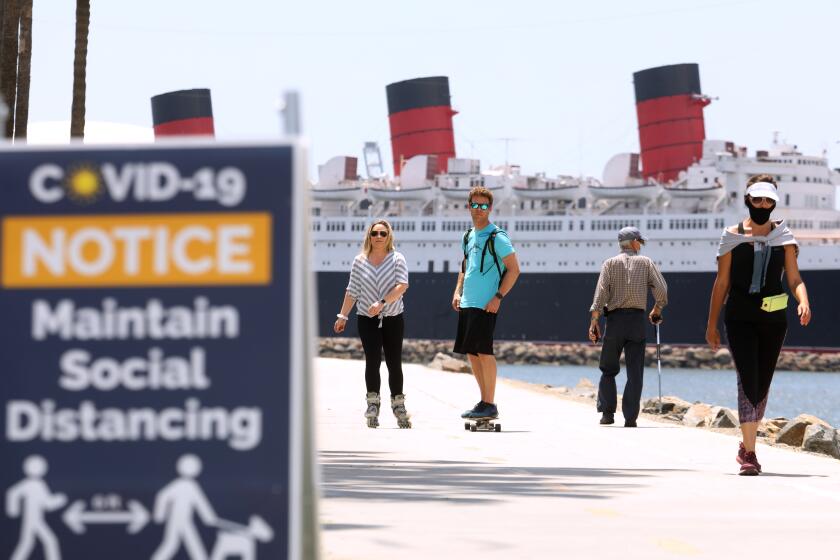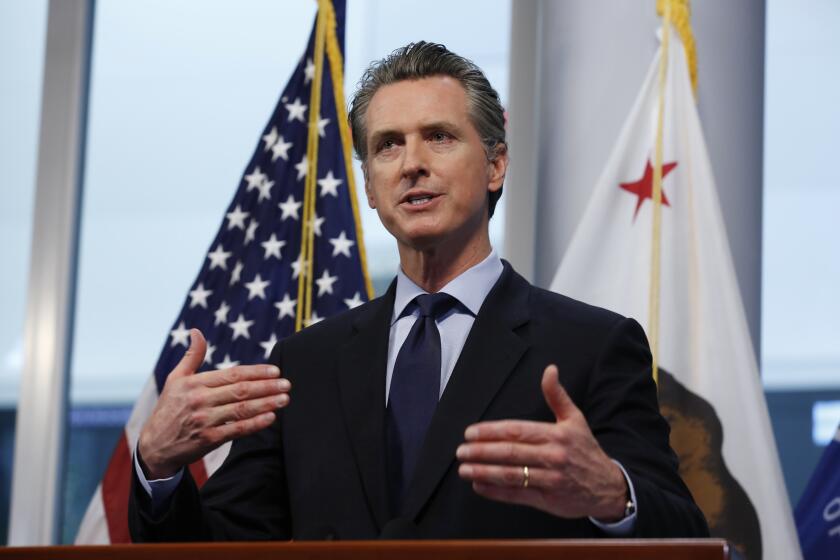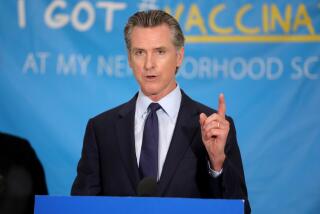Newsom says California shutdown must continue, but surge in testing will help

SACRAMENTO â Gov. Gavin Newsom on Wednesday announced an expansion of coronavirus testing capability throughout California, saying the findings will be critical to deciding when to ease the stateâs strict stay-at-home order and allow people to return to work.
Newsomâs announcement comes as more and more cities and counties have urged him to modify the restrictions, which they say have put local economies on the brink of ruin. The governor has thus far resisted, saying that COVID-19 remains a serious and growing health threat and that loosening his statewide order prematurely could lead to a second wave of infections and fatalities.
But Newsom said the prospect of lifting the restrictions becomes more feasible with widespread testing. The data will increase the ability of public health officials to closely track potential cases, one of the most essential requirements for California to ease into the next phase of the pandemic while still stemming the spread of the virus.
The governor announced several new efforts to increase testing in California, noting that President Trump committed in a phone call Wednesday to providing California with critically needed specimen swabs for coronavirus testing, which have been in short supply. Newsom said 100,000 swabs are expected to arrive in California this week and 250,000 next week.
The governor said six new testing sites will become operational soon, prioritizing âblack and brown communities and focusing on rural communities.â
Newsom announced that Abbott Laboratories will provide California with 1.5 million serology tests, which detect antibodies. One of his top health advisors warned that the science is evolving and that serology tests cannot yet confirm immunity.
The âCalifornians for Allâ effort focuses on a new web-based application for those willing to volunteer in a variety of ways.
âWe plan to use those, first and foremost, to understand the prevalence of disease across the state,â said Dr. Mark Ghaly, the stateâs secretary of Health and Human Services. âWe know that any accurate movement forward with modification of the stay-at-home order requires us to understand who might have been infected in the past.â
The new initiatives would substantially increase Californiaâs coronavirus testing capabilities, which currently average 14,500 tests a day among all public and private labs. The Newsom administrationâs target is 25,000 tests a day by the end of April and up to 80,000 daily tests in the near future.
This week, California became the first state to recommend tests for asymptomatic people living or working in high-risk settings such as nursing homes and prisons, a significant first step toward establishing widespread testing to identify and isolate every coronavirus case.
The Newsom administration last week highlighted six key indicators for altering the governorâs stay-at-home order. In addition to increased testing, they include acquiring the ability to prevent infection of high-risk people; preparing hospitals to handle surges; developing therapies to meet demand; ensuring schools, businesses and child-care facilities can support social distancing; and developing guidelines for when to ask Californians to stay home again if necessary. The governor has declined to say when he might begin to modify his order and ease restrictions.
âI deeply recognize, deeply understand the desire for people to hear directly from the administration, from the state and its leadership, about the answer to when, when can we go back to some semblance of normalcy,â Newsom said during a COVID-19 briefing Wednesday. âI wish I could prescribe a specific date to say, well, we can turn up the light switch and go back to normalcy. We have tried to make it crystal clear that there is no light switch. And there is no date in terms of our capacity to provide the kind of clarity that I know so many of you demand and deserve.â
Some smaller California communities want to begin easing stay-at-home restrictions, saying they have made enough progress against the coronavirus.
Newsom laid out a goal of training 10,000 people, including some existing state workers, to support counties to track COVID-19 patients and anyone who may have come in contact with those people.
âThe good news is we believe we have the capacity to build an army of tracers, beginning with a goal of 10,000,â Newsom said.
Newsom also announced that the California hospital system is in good enough shape for the state to begin lifting restrictions on other procedures at medical facilities.
âWe are in a position today to begin to pull back and lean in by beginning to schedule surgeries, once again, throughout not only our hospital system but our broader healthcare delivery system,â Newsom said.
âI wish I could prescribe a specific date to say, well, we can turn up the light switch and go back to normalcy. We have tried to make it crystal clear that there is no light switch. And there is no date in terms of our capacity to provide the kind of clarity that I know so many of you demand and deserve.â
— Gov. Gavin Newsom
But Newsomâs methodical approach comes as governors in other states, including Colorado, Texas and Georgia, already have announced plans to ease their stay-at-home restrictions.
Colorado Gov. Jared Polis on Monday said his state would transition to a âSafer at Homeâ phase at the end of the month, which will urge people to stay home and continue to practice social distancing, and will allow small businesses including hair salons and barbershops to eventually reopen if they adhere to certain health guidelines.
Polis said he hopes bars and restaurants could reopen in mid-May, but that would be contingent on what happens after the stay-at-home directive is lifted.
Trump has openly encouraged protesters defying state stay-at-home orders throughout the country and often expresses an eagerness to reopen the American economy that has plummeted into recession because of the virus outbreak.
Still, after several Southern states took action this week to lift their stay-at-home orders, Dr. Anthony Fauci, director of the National Institute of Allergy and Infectious Diseases, warned Americans that returning too quickly to life as it was before the pandemic would âbackfireâ and lead to a resurgence of the virus.
In his daily briefings, Newsom also has warned about the consequences of easing restrictions too soon. Newsom said Californians have been successful in slowing the spread of the virus by adhering to orders to stay at home and maintain social distancing â but infections continue to rise.
Newsom said that while areas across the state have been affected differently by the pandemic, the âvirus knows no jurisdiction, knows no boundariesâ and could easily spread into neighboring counties if they ease restrictions prematurely.
On Wednesday, Newsom cited administration statistics from the previous 24-hour period showing a 0.2% decrease in hospitalizations and a 1.8% decline in patients being treated in intensive care wards.
âWe have flattened the curve, weâve created stability,â Newsom said. âContinue to practice physical distancing and we will be making more announcements sooner than we otherwise would. If we pull back too soon, those announcements will not be forthcoming.â
Newsom said that if restrictions are eased in a few counties or cities that have been less affected by the pandemic, cases could quickly surge if infected people from other parts of the state pass through those areas. He said that itâs critical to the well-being of all Californians to have a statewide, health-based strategy to return to some sense of normalcy.
Officials in San Luis Obispo County asked the governor to allow them to ease their stay-at-home rules because they were in a much better position than coronavirus hot spots such as Los Angeles and Santa Clara counties. In a letter to Newsom, local officials said that the countyâs infection rate had been on the decline for three weeks and that COVID-19-related hospitalizations had dropped dramatically. At the beginning of this week, the county reported 130 positive cases, with 111 fully recovered, three people in the hospital and one death.
They promised to ease the restrictions in a measured way that ensured that public health would not be endangered, but Newsom has not been swayed thus far.
Newsom appeared more deferential to local officials at the outset of the pandemic. That included allowing cities and counties to decide how to enforce the stay-at-home order and whether to require residents to wear face coverings when leaving home to shop for groceries or for other essential needs.
After Los Angeles Mayor Eric Garcetti this month required residents to wear face coverings when shopping, Newsom praised the decision, though he declined to issue an executive order requiring similar precautions statewide.
âLocalism is determinative,â Newsom said during an April 7 briefing. âWe really look for leadership at the local level, and Mayor Garcetti has been providing that ⌠and youâre seeing that kind of leadership manifest all across the state where people are taking our baseline recommendations and guidance and they are conditioning, based on local realities, them even further.â
Times staff writer John Myers contributed to this report.
More to Read
Sign up for Essential California
The most important California stories and recommendations in your inbox every morning.
You may occasionally receive promotional content from the Los Angeles Times.








![[20060326 (LA/A20) -- STATING THE CASE: Marchers organized by unions, religious organizations and immigrants rights groups carry signs and chant in downtown L.A. "People are really upset that all the work they do, everything that they give to this nation, is ignored," said Angelica Salas of the Coalition of Humane Immigrant Rights. -- PHOTOGRAPHER: Photographs by Gina Ferazzi The Los Angeles Times] *** [Ferazzi, Gina -- - 109170.ME.0325.rights.12.GMF- Gina Ferazzi/Los Angeles Times - Thousands of protesters march to city hall in downtown Los Angeles Saturday, March 25, 2006. They are protesting against House-passed HR 4437, an anti-immigration bill that opponents say will criminalize millions of immigrant families and anyone who comes into contact with them.]](https://ca-times.brightspotcdn.com/dims4/default/34f403d/2147483647/strip/true/crop/1983x1322+109+0/resize/840x560!/quality/75/?url=https%3A%2F%2Fcalifornia-times-brightspot.s3.amazonaws.com%2Fzbk%2Fdamlat_images%2FLA%2FLA_PHOTO_ARCHIVE%2FSDOCS%2854%29%2Fkx3lslnc.JPG)






